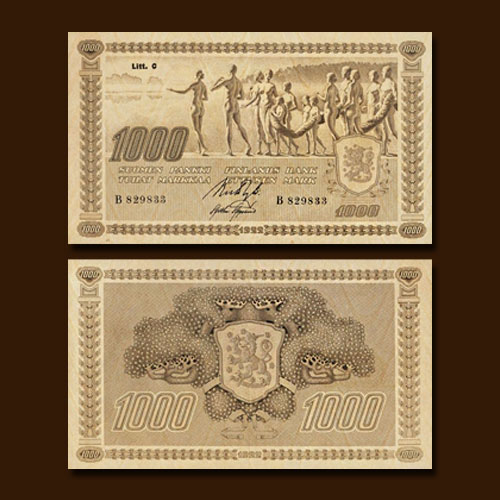First Note Series of Finland after Independence
2020-02-28 Fri
Finland is a Northern European nation bordering Sweden, Norway, and Russia. Finland had received its own monetary unit, the markka, tied to the Russian rouble, which itself was a fluctuating currency. The name ‘markka’ was defended by the fact that it was the oldest name for money in Finland. Originally, it had been used for a medieval unit of weight.Finnish banknotes reflect the country's economic and political history. The shortage of silver at the beginning of the 20th century led to the completion of the banknote series with 1 markka, 25 penni and 50 penni notes. When country gained independence in the year 1922 a new series of notes were issued.
This series comprised of four denominations viz. 50, 100, 500 and 1000 Finnish markkas. The series represents the classicism of the 1920s; however, some traces of Art Nouveau still persist. The banknote depicts featurie 13 allegorical nude and seminude persons on a beach or lake on the obverse along with the denomination value, promissory note and the signature of the authority. The reverse has the Arms set in the middle of a mystical pine tree, with the 1922 date printed below.
The nude figures caused some controversy when the note was first introduced. The almost spiritual atmosphere with its train of people bearing a garland on a hazy lake shore towards the bright dawn of the newly-independent Finland, is reminiscent of earlier murals in the Tampere cathedral - 'The Procession of the Blessed' by Magnus Enckell and friezes depicting garland bearers by Hugo Simberg.
Image Courtesy: numisbids
Latest News
-
Ghiyath Shah as Heir Apparent
2025-09-25 ThuGhiyath Shah was the ruler of the Malwa Sultanate, reigning from 1456 to 1500. From 1456 to 1469, he...
-
Malwa Sultan Mahmud Shah Silver Coins
2025-09-11 ThuMalwa Sultan Mahmud Shah minted silver coins in round and square flans. <br><br> For round coins,...
-
Malwa Sultan Mahmud Shah Billon coin
2025-08-26 TueMalwa Sultan Mahmud Shah's billon coins followed three weight standards: 100 rati, 96 rati, and 80 r...
-
Fascinating Archaeological Facts on Postage Stamps - 91
2025-08-23 SatRhinoceros is one of the oldest land mammal species existing in India. There are five species of rhi...
-
Fascinating Archaeological Facts on Postage Stamps - 90
2025-08-23 SatUthiramerur, a Village in Kanchipuram, Tamil Nadu, is notable for its Temple inscriptions that descr...

